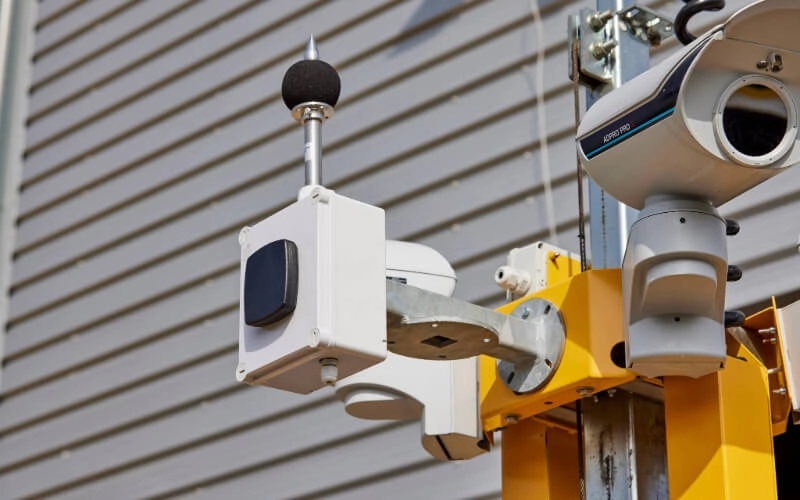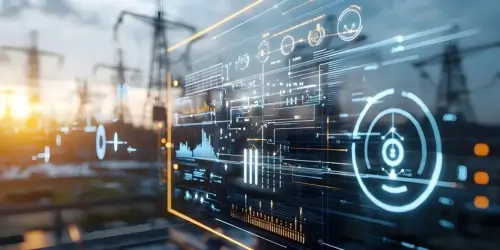Compliance culture is shifting, with regulations tightening in the UK and growing ESG expectations, it is no longer considered a tick boxing exercise, but rather a strategic function to a construction firm’s operations.
However, even with these risks, many construction firms still rely on manual processes like spreadsheets which drain resources, risk inaccuracies and lead to compliance breaches.
Smart monitoring systems are transforming these manual processes into automated technology that brings together security, compliance and environmental sustainability that allows you to make informed, data-backed decisions that better your business.
The Compliance Challenges: Rising Regulations, Limited Resources, Real Risks
HSE, the ICO and environmental standards expectations have grown heavily in recent years, leading to an unprecedented rise in regulatory changes, which continue to change on a regular basis.
For compliance leaders managing small teams faced with resource constraints, manual reporting and fragmented systems, every update increases administrative burden and risk of non-compliance breaches.
One small oversight could lead to a hefty fine and potential legal action, both of which are likely to negatively impact your firm’s reputation.
With fines for health and safety breaches increasing, and GDPR penalties also climbing, the stakes are higher than ever before. Only last month a construction company was fined £1m for the death of an employee linked to a number of failings identified by HSE.
Alone this emphasises the regulatory risks and importance of prioritising worker safety. Breaches expose construction firms to operational, financial and reputational risks if the incorrect tools and visibility continue to be left in place.
This is where the introduction of smart monitoring systems can support firms by combining AI detection, enhanced incident response and automated reporting, helping to alleviate compliance teams from the time-consuming nature and risk of inaccuracies from manual processes.
How Technology Reframes Compliance as a Strategic Advantage for Construction Firms
Often seen as a tick-boxing exercise, compliance has been an essential part of any construction firm, however, the approach tends to be reactive and resource heavy.
Modern technology like smart monitoring systems can significantly enhance this approach by transforming compliance from simply a regulatory obligation to a strategic enabler for a business.
From transparent evidence gathering and real-time risk alerts to automated reporting and centralised dashboard for multi-site monitoring, compliance teams no longer face the tedious and time-consuming task of manual reporting.
By offering complete visibility of sites and maintaining clear audit trails, smart monitoring systems transition the approach of compliance teams from reactive to proactive. Helping predict risks, proactively manage dangers throughout the day, simplify audit reviews and demonstrate measurable improvement to stakeholders.
This switch ensures sites operate safely and remain audit-ready whilst futureproofing construction firms’ reputations, supporting them with future tenders and in building trust with clients.
Essentially it’s reframing compliance from the ‘rep tape’ view many still hold to displaying due diligence to protect employees, the local community and clients, both physically and financially.
Smart Monitoring Systems Explained
Talking about the benefits of smart monitoring systems is only beneficial if you’re aware of what they are, and the key features they actually offer.
What Are Smart Monitoring Systems?
A smart monitoring system is an integrated platform that utilises technology to connect sensors, CCTV surveillance and real-time data analytics to automatically track, assess and report what’s happening throughout your sites.
In comparison to traditional methods like security guards, smart monitoring systems continuously gather information day and night, providing timestamped evidence on incidents, risks, site behaviour and environmental conditions.
As this information is gathered, the systems will send real-time alerts or generate reports depending on the evidence logged. This could be air quality level exceeding thresholds or an intruder has been identified.
In all, smart monitoring systems offer a centralised platform that strengthens compliance, minimises security risks, enhances worker safety and improves operational oversight through audit-ready, evidence-backed data.
Key Features of Smart Monitoring Systems for Compliance Leaders
Construction holds the most work-related fatalities in the UK during 2024/25, with 35 deaths reported. Making one compliance failure could result in disastrous consequences for a construction firm.
Smart monitoring systems are designed with key features specifically to monitor key areas of risks for construction site safety and security.
PPE Detection for HSE Compliance - Using smart analytics, smart monitoring systems automatically verify if workers are wearing the correct PPE on-site. Whether it’s missing hard hats, high vis or goggles. This provides compliance teams and site managers complete visibility of any safety risks, allowing them to react in real-time, and creates reliable logs for any reviews or HSE inspections.
Noise and CO₂ Monitoring for Environmental and ESG Reporting - Real-time sensors track noise and CO2 production, alerting teams instantly when thresholds are exceeded. This allows compliance leaders to take action to improve site safety and avoid compliance breaches. The data captured for environmental reporting can be used to display due diligence during inspections and with ESG disclosures.
Dust and Air Quality Tracking - Air quality monitoring sensors integrate into smart monitoring systems to continuously provide data on dust and particulate matter. This information aims to maintain safe air quality and protect workers’ safety through real-time alerts. Whilst also providing an accurate audit trail for environmental and occupational health compliance.
Intruder Detection and Automated Incident Logs - Smart cameras utilise AI technology to identify intruders in real time, automatically triggering criminal deterrent features and creation of an incident report. This helps to reduce common construction crime like theft, improve site safety and provide evidence for criminal investigations.
Weather Monitoring to Plan Project Schedules - Live weather sensors monitor wind, rainfall, temperatures and lightning to help teams plan project schedules, anticipate delays and adjust machinery usage based on the proactive insights provided. This minimises the risk of weather-related injuries and compliance failures.
Smoke and Fire Detection to Manage Electrical Dangers - Smoke and fire detection systems help identify signs of a fire before it escalates into a serious incident. From smoke to colour changes, they monitor sites day and night, allowing compliance leaders to respond quickly to these incidents and have an accurate record following the event. In turn, this demonstrates adherence to fire standards.
Related articles:

Moving From Manual to Measurable Compliance With Smart Monitoring
In an industry heavily reliant upon manual checks, spreadsheets and retrospective reporting, construction compliance is currently time-consuming, prone to human error and inconsistent.
The overall risk from this: compliance breaches, which lead to financial penalties, legal and liability claims as a business and personally.
Smart monitoring systems replace these reactive systems, and in the process, save time, money and resources. Providing continuous, automated data gathering from multiple sensors, camera feeds and detection systems, they offer insights into site safety, environmental performance and regulatory compliance.
The result? Compliance teams aren’t left scrambling for documentation to support with audits, and instead, are helping them to gain visibility across all sites from one centralised dashboard in the click of a button.
Creating reports in a matter of minutes, firms can now easily demonstrate their due diligence to workers and regulations like HSE. These also support faster decision-making within compliance, with evidence data to back this.
Not only does this benefit compliance teams in reducing the time spent on reporting and enhancing decision-making, but in transforming operations.
Related articles: What Are Smart Analytics Insights Within Construction?
Building a Culture of Compliance and Accountability
One of the main challenges faced within construction is the strong belief that compliance is ‘red tape’, blocking projects from progressing or creating unnecessary limitations on site.
Simply updating policies and introducing training isn’t enough to build a positive compliance culture. It relies on consistency, clarity and accountability being held across every level of the business, from front-line workers to directors.
Smart monitoring systems are found to be some of the most successful ways in doing this, providing performance transparency, real-time feedback and environmental insights to support on-the-ground.
This may include informing a worker of wearing incorrect PPE or suspending crane work during heavy winds.
The biggest downfall for construction firms when it comes to compliance culture is not being transparent with workers. By showing them the direct impact of the actions taken, workers are able to gain a better understanding that compliance is an enabler, not a blocker.
For site managers, smart monitoring systems provide real-time insights and accurate data to reinforce best practice on their sites. This empowers them to become strategic leaders in compliance themselves, ensuring that safety is an integral part of their day-to-day role.
By promoting accountability and responsibility on an individual level across every level of the business, you’ll foster a culture embedded into the daily workflow. In turn, reducing risks and workplace injuries whilst strengthening your relationships with clients, regulators, insurers and internal stakeholders.
Related articles: Improving Construction Site Health and Safety with CCTV
Proving the Impact: Efficiency, Risk Reduction and Return on Compliance
Compliance leaders are faced with growing challenges of regulatory expectations, and with this, construction firms expect teams to demonstrate measurable value of any supporting tools and systems used.
Smart monitoring systems provide this data, displaying measurable impact to board members and stakeholders. From the time reduced by replacing manual processes, minimising the risk of work-related injuries and lowering exposure to fines and insurance claims.
Through automated logs, real-time alerts and a centralised platform, compliance teams and site managers with a clear oversight across all sites, giving them insight of their operational performance and risk.
Using this, compliance teams and site managers can make informed, data-backed decisions quickly, rather than reacting after an incident has occurred.
These benefits from smart monitoring systems show tangible returns for a business:
-
Fewer project delays
-
Positive audit results - avoid fines and legal penalties
-
Greater efficiency with resources
-
Fewer work-related incidents - displaying enhanced site safety

How Smart Monitoring Systems Future-Proof Compliance in Construction
With regulations from HSE continuing to tighten and ESG expectations only on the rise from auditors and stakeholders, futureproofing compliance is an essential part in maintaining business operations.
Smart monitoring systems provide a data-driven solution that is both scalable across multiple sites and adaptable to the changing landscape of compliance. Providing automated evidence gathering and reporting, these systems ensure secure audit trails that can be adjusted as industry standards change.
By bringing together safety, environmental and access control data into one centralised platform, construction firms are able to respond quickly to any regulatory changes without risking a compliance breach.
This demonstrates continuous commitment to being audit ready as a business whilst reducing workload. In doing this, compliance teams can then stay ahead of any upcoming adjustments like air quality thresholds and new compliance reporting requirements, helping ensure long-term compliance.
From reducing risks to ensuring you have a competitor’s edge, smart monitoring systems support construction firms in futureproofing their business in an already competitive and expansive market.
Stellifii: Leading the Future of Compliance Through Smart Technology
At WCCTV, we developed Stellifii, an integrated smart monitoring system that combines CCTV surveillance, smart detection, environmental monitoring, cloud-based audit trails and automated reporting into one centralised platform.
This gives compliance leaders complete visibility and security across every site, providing control in just a click of a button, wherever they are.
Compared to manual processes which involve manual checks and fragmented systems, Stellifii automates reports and provides evidence-ready insights. Construction firms can use this data to strengthen safety, meet changing regulations and reduce risks on-site.
Below’s table offers a clear, side-by-side comparison of how Stellifii outperforms traditional compliance monitoring and reporting methods:
| Functionality | Traditional Methods | Stellifii Smart Monitoring |
| PPE Compliance | Relies on manual site inspections, creating a high risk of missed compliance breaches. | Automated PPE detection with real-time alerts and timestamped video evidence. |
| Environmental Monitoring (Noise, CO₂, Dust) | Measurements taken manually, often leading to missed compliance breaches or incorrect readings. | Continuously monitors environmental levels through sensors. With live dashboards and real-time notifications when thresholds are exceeded. |
| Incident Logging | Uses paper logs, spreadsheets and delayed reporting which is prone to human error. | Automatically logs incidents with secure, encrypted data pathways stored in a cloud-based platform. |
| Audit Readiness | Manual evidence gathering from multiple sources makes a time-consuming process for teams. | Instant audit-ready reporting at a click of a button, through a centralised platform. |
| Risk Visibility | Evidence gathering collected through fragmented systems makes it difficult to detect issues early. | Real-time visibility of all sites via a mobile app or desktop, enabling proactive risk management. |
| Data Accuracy | Subjective manual reporting which is often inconsistent. | Objective, automated data collection through sensors, cameras and AI analytics, providing timestamped evidence. |
| Operational Efficiency | High administration work and labour intensive due to the manual checks, incident logging and reporting required. | Highly efficient reporting due to automation of reports, incident logs and continuous monitoring. Frees up time for compliance teams. |
| Accountability & Culture | Low visibility leads to a lack of individual and business accountability. Continues to create a ‘red tape’ culture around compliance. | Transparent reporting and performance monitoring that encourages a culture of accountability and compliance throughout your sites, and wider firm. |
| Cost of Compliance | High long-term costs caused by the inefficiencies, delays and increased risk of fines. | Low costs through automation, reduced incidents and stronger audit outcomes. |
With the support of Stellifii, our security systems enhance construction firms to move beyond the manual methods currently used and replace them with a smarter, data-driven offering that strengthens safety, reduces risks and futureproofs your business.
Whether it’s our CCTV Towers or Redeployable CCTV Cameras, Stellifii brings everything together, minimising workload and pressure from compliance teams and allowing them to think ahead.
Ready to modernise your compliance strategy? Speak to our team today to see how Stellifii can transform your site monitoring, streamline audits and give you complete confidence in every compliance decision.




